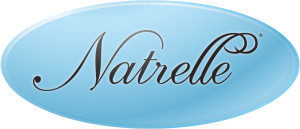 Natrelle® is the brand name registered by Allergan, Inc. for their line of breast implants, designed and FDA (United States Food and Drug Administration) approved for surgeons to use in breast augmentation and breast reconstruction. Natrelle® implants are available in round and “dimensional” shapes to fit women with all varieties of presentation, and all reasonable desired aesthetic results.
Natrelle® is the brand name registered by Allergan, Inc. for their line of breast implants, designed and FDA (United States Food and Drug Administration) approved for surgeons to use in breast augmentation and breast reconstruction. Natrelle® implants are available in round and “dimensional” shapes to fit women with all varieties of presentation, and all reasonable desired aesthetic results.
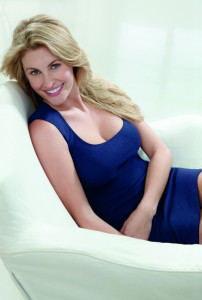 Natrelle® implant volumes range from a low of about 180 ml. to a high of about 800 ml. Widths range from 9 cm. to 17 cm., and forward projection from 2 cm to 7 cm. The widest range of available sizes and shapes are produced with cohesive silicone gel or highly cohesive silicone gel fill within a solid silicone shell. Cohesive silicone gel implants are highly viscous with a natural texture, and highly cohesive (Style 410) implants are semi-solid with a “gummy bear” texture. Solid breast implant shells are also available with a valve on the surface for inflation with a recommended volume of saline (salt water) fill. Saline implants deflate upon shell failure, have a less natural texture than cohesive silicone gel, and are prone to rippling and wrinkling of the shell which can be seen and/or felt through breast skin of lean women and women with little native breast tissue.
Natrelle® implant volumes range from a low of about 180 ml. to a high of about 800 ml. Widths range from 9 cm. to 17 cm., and forward projection from 2 cm to 7 cm. The widest range of available sizes and shapes are produced with cohesive silicone gel or highly cohesive silicone gel fill within a solid silicone shell. Cohesive silicone gel implants are highly viscous with a natural texture, and highly cohesive (Style 410) implants are semi-solid with a “gummy bear” texture. Solid breast implant shells are also available with a valve on the surface for inflation with a recommended volume of saline (salt water) fill. Saline implants deflate upon shell failure, have a less natural texture than cohesive silicone gel, and are prone to rippling and wrinkling of the shell which can be seen and/or felt through breast skin of lean women and women with little native breast tissue.
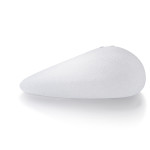 Breast implant positioning is selected during consultation with Dr. Steve Laverson. Advantages of placement behind the breast gland are that overlying breast conforms to implant shape readily, “animation” of the implants with arm motion and chest muscle contraction are avoided, and the procedure disturbs less anatomy. Advantages of placement behind the breast and the pectoralis major chest muscle are deeper positioning of the implant for better camouflage of breast implant edges, less visible wrinkling and/or rippling of implant edges, and slightly easier mammograms. Data regarding the incidence of capsular contracture is controversial with respect to advantages of one implant position over another, but several studies suggest that contracture may be diminished when breast implants are submuscular (beneath chest muscle). In reality, “beneath the muscle” or “submuscular” positioning still leaves the lower outer 30-60% of the breast implant surface beneath the breast gland because the pectoralis major muscle doesn’t extend to the lower outer quadrant of the female breasts. Submuscular and “dual plane” positioning are thus synonyms.
Breast implant positioning is selected during consultation with Dr. Steve Laverson. Advantages of placement behind the breast gland are that overlying breast conforms to implant shape readily, “animation” of the implants with arm motion and chest muscle contraction are avoided, and the procedure disturbs less anatomy. Advantages of placement behind the breast and the pectoralis major chest muscle are deeper positioning of the implant for better camouflage of breast implant edges, less visible wrinkling and/or rippling of implant edges, and slightly easier mammograms. Data regarding the incidence of capsular contracture is controversial with respect to advantages of one implant position over another, but several studies suggest that contracture may be diminished when breast implants are submuscular (beneath chest muscle). In reality, “beneath the muscle” or “submuscular” positioning still leaves the lower outer 30-60% of the breast implant surface beneath the breast gland because the pectoralis major muscle doesn’t extend to the lower outer quadrant of the female breasts. Submuscular and “dual plane” positioning are thus synonyms.
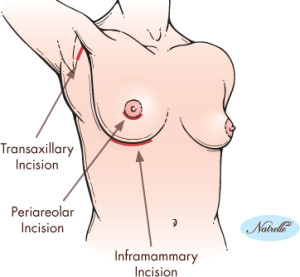 Approaches for insertion of breast implants depends on individual preference, implant selection (large implants difficult to insert through small areola and armpit approach), and your anatomy. Dr. Steve Laverson is an experienced breast surgeon who prefers placing implants through a 5 cm opening at the bottom crease of the breast in many cases because this approach doesn’t interfere with breast feeding, preserves the nipple area as the unscarred focal point of breast sensuality, heals well and is hidden in the vast majority of cases. Also, there is data to suggest that capsular contracture may be more likely if a breast implant is inserted through the areola because division of breast ducts inevitably occurs when placing the implant through this opening. These ducts contain bacteria which may produce biofilms that have been implicated in capsular contracture, a complication of breast augmentation surgery.
Approaches for insertion of breast implants depends on individual preference, implant selection (large implants difficult to insert through small areola and armpit approach), and your anatomy. Dr. Steve Laverson is an experienced breast surgeon who prefers placing implants through a 5 cm opening at the bottom crease of the breast in many cases because this approach doesn’t interfere with breast feeding, preserves the nipple area as the unscarred focal point of breast sensuality, heals well and is hidden in the vast majority of cases. Also, there is data to suggest that capsular contracture may be more likely if a breast implant is inserted through the areola because division of breast ducts inevitably occurs when placing the implant through this opening. These ducts contain bacteria which may produce biofilms that have been implicated in capsular contracture, a complication of breast augmentation surgery.
Dr. Steve Laverson is a Breast Enhancement San Diego surgeon who sometimes performs augmentation through an armpit approach, but this is his third choice because implant size is restricted, textured surface devices are more difficult to properly position through the armpit, nerves to the arm may be injured, and vital structures such as blood vessels and the pectoralis major muscle origin are more difficult to clearly visualize during surgery. Also, positioning of the bottom crease of the breast is more challenging through the armpit.
Breast Implant Surfaces (Textured vs. Smooth)
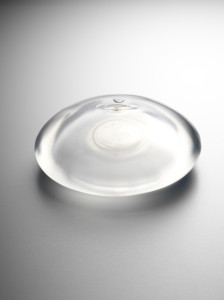
Breast implants (prostheses) all have a solid silicone shell. The surface of this flexible solid shell may be smooth or rough (textured). Smooth surface implants appear translucent and glossy, while textured surface implants have a rough surface and opaque, ground glass appearance. Dr. Laverson demonstrates both of these implant types at consultation. Textured and smooth surface implants both may be filled with silicone or with saline. Differences in behavior (implant-tissue interaction) between smooth and textured surface implants have been studied only on a limited basis, and both are acceptable to use in most situations.
Because of the rough surface of textured implants, Dr. Laverson has observed they are more likely to stay exactly where he puts them during breast augmentation. He believes they are less likely to drop after surgery, and less likely to deviate laterally when placed beneath the pectoralis (chest) muscle. Dr. Laverson prefers textured implants when placing the devices beneath the pectoralis muscle. The implant is wedged between muscle in front and the curved ribs behind. Contraction of the muscle during use of the arms applies force to the front of the implant and on its inner aspect, tending to push it out toward the side and down. The capsule your body forms around a textured implant surface grabs the rough surface and like a tire with a deeper tread, resists this downward and outward force. The smooth surface implant slides more easily and with its lower coefficient of friction may be more prone to displacement when placed beneath the pectoralis major muscle.
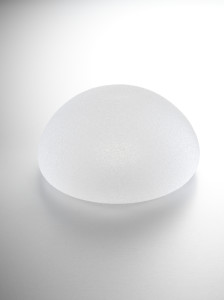
Smooth surface implants however, probably have an advantage when the implant position is subglandular (in front of the pectoralis major muscle). To produce a soft implant that assumes a natural shape, the implant shell is not filled to capacity during the manufacturing process. This allows the implant to shift its shape like the natural breast with changes in body position. Normal behavior of the implant is to wrinkle slightly at the top because of this underfill. In thin, lean women, women with large implants, and women with implants in subglandular position, these implant wrinkles may be transmitted to the skin, which produces a very artificial appearance, and discloses the presence of implants. This tendency is magnified when a textured surface prosthesis is subglandular, because the textured surface grips the capsule, which is attached to overlying soft tissue and skin. Thus, when a superficially placed textured implant ripples, these ripples may be more visible on the skin surface than if the superficially placed implant is smooth, and less likely to be adherent to the capsule.
Depending on your body type, your lifestyle, your preferences, and the size implant you select, Dr. Laverson may recommend smooth surface or textured surface implants. There is no cost difference.

 Book Now
Book Now









